
GY Andromedae is an α2 Canum Venaticorum type binary variable star in the northern constellation Andromeda. Its brightness fluctuates in visual magnitude between 6.27m and 6.41m, making it a challenge to view with the naked eye even in good seeing conditions. The magnetic activity on this star shows an unusually long period of variability, cycling about once every 23 years. Based upon parallax measurements, this star is located at a distance of about 460 light-years from the Earth.

12 Canis Majoris is a variable star located about 707 light years away from the Sun in the southern constellation of Canis Major. It has the variable star designation HK Canis Majoris; 12 Canis Majoris is the Flamsteed designation. This body is just barely visible to the naked eye as a dim, blue-white hued star with a baseline apparent visual magnitude of +6.07. It is moving away from the Earth with a heliocentric radial velocity of +16 km/s. This is the brightest star in the vicinity of the open cluster NGC 2287, although it is probably not a member based on its proper motion.

Iota Cassiopeiae is a star system in the constellation Cassiopeia. The system has a combined apparent magnitude of 4.53, making it visible to the naked eye. Based on its parallax, it is located about 133 light-years from Earth.

HD 125823, also known as V761 Centauri or a Centauri, is a variable star in the constellation Centaurus. It is a blue-white star that is visible to the naked eye with a mean apparent visual magnitude of +4.41. The distance to this star is approximately 460 light years based on parallax measurements. It is a member of the Upper Centaurus–Lupus subgroup of the Scorpius–Centaurus association.

HD 4778, also known as HR 234 and GO Andromedae, is a variable star in the constellation Andromeda. Its magnitude varies by 0.04 magnitudes from the median of 6.12 with a period of approximately 2.55 days. The star is located 350 light years away, as determined from its annual parallax shift of 9.32 mas.

HD 224801, also known as CG Andromedae, is an Alpha2 Canum Venaticorum variable star in the constellation Andromeda. Located approximately 188 parsecs (610 ly) away, the star varies between apparent magnitudes 6.32 and 6.42 over a period of approximately 3.74 days.

V538 Aurigae is a single star in the northern constellation of Auriga. With an apparent visual magnitude of 6.23, this star requires good dark sky conditions to view with the naked eye. It is located at a distance of 40.0 light-years (12.3 pc) from Sun based on parallax. The star is drifting further away with a radial velocity of 0.9 km/s. It is a member of the Local Association, and is most likely a thin disk star.
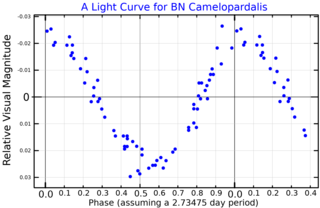
BN Camelopardalis is a suspected astrometric binary in the northern circumpolar constellation of Camelopardalis. It appears as a variable star that is visible to the naked eye as a dim, white-hued point of light with an apparent visual magnitude that fluctuates around 5.49. The system is located at a distance of around 310 light years from the Sun based on parallax, and is drifting further away with a radial velocity of +9 km/s.

HD 93194 is a star in the constellation Carina. Its apparent magnitude is 4.79. Its parent cluster is IC 2602.

HD 93607 is a star in the constellation Carina. Its apparent magnitude is 4.87. Its parent cluster is IC 2602.
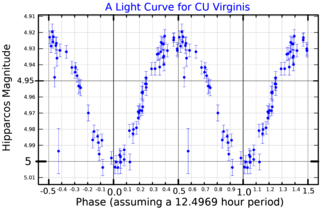
CU Virginis is a single star in the equatorial constellation of Virgo. It has an apparent visual magnitude of 4.99, which is bright enough to be faintly visible to the naked eye. The distance to this star can be estimated from its annual parallax shift of 13.9 mas, yielding a separation of 234 light years.

Y Centauri or Y Cen is a semiregular variable star in the constellation of Centaurus.

HD 137509 is a star in the southern constellation of Apus, positioned less than a degree from the northern constellation boundary with Triangulum Australe. It has the variable star designation of NN Apodis, or NN Aps for short, and ranges in brightness from an apparent visual magnitude of 6.86 down to 6.93 with a period of 4.4916 days. The star is located at a distance of approximately 647 light years from the Sun based on parallax, and is drifting further away with a radial velocity of +0.50 km/s.

V957 Scorpii is a variable star in the constellation of Scorpius. It is a blue straggler in the open cluster Messier 7, a star that is unexpectedly hot compared to other members of the cluster. A 6th magnitude star, it is faintly visible to the naked eye under very good observing conditions.

HR 3831, also known as HD 83368, is a binary star system in the southern constellation of Vela at a distance of 233 light years. This object is barely visible to the naked eye as a dim, blue star with an apparent visual magnitude of 6.232. It is approaching the Earth with a heliocentric radial velocity of 4.0±0.3 km/s.
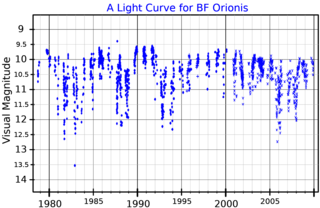
BF Orionis is a young Herbig Ae/Be star in the constellation of Orion about 1250 light years away, within the Orion Nebula. It is the most massive star of the small birth cluster of four stars.
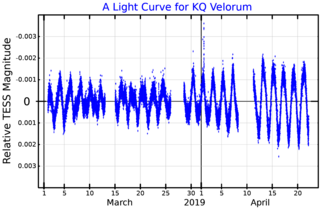
KQ Velorum is a variable star system in the southern constellation of Vela. It has the identifier HD 94660 in the Henry Draper Catalogue; KQ Vel is the variable star designation. This appears as a sixth magnitude star with an apparent visual magnitude of 6.112, and thus is dimly visible to the naked eye under suitable viewing conditions. The system is located at a distance of approximately 373 light years from the Sun based on parallax measurements, and is drifting further away with a radial velocity of around 23 km/s.
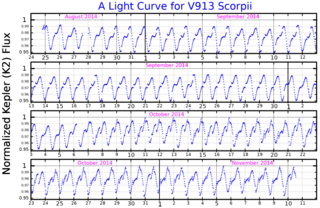
HD 142990, also known as HR 5942 and V913 Scorpii, is a star about 470 light years from the Earth, in the constellation Scorpius. It is a 5th magnitude star, so it will be faintly visible to the naked eye of an observer far from city lights. It is a variable star, whose brightness varies slightly from 5.40 to 5.47 during its 23.5 hour rotation period. It is a member of the Upper Scorpius Region of the Scorpius–Centaurus association.

EK Eridani is a single variable star in the equatorial constellation of Eridanus. It has the designation HR 1362 from the Bright Star Catalogue; EK Eridani is the variable star designation, abbreviated EK Eri. This star is dimly visible to the naked eye with a brightness that fluctuates around 6.15. Based on parallax measurements, it is located at a distance of 209 light years from the Sun. The star is drifting further away with a heliocentric radial velocity of 6.9 km/s.
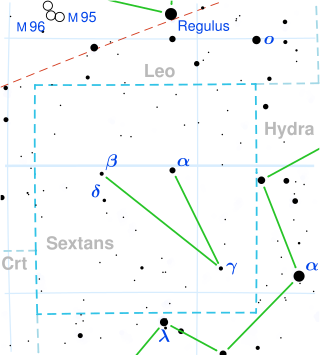
25 Sextantis, or simply 25 Sex, is a star located in the equatorial constellation Sextans; it also bears the variable star designation SS Sextantis. With an average apparent magnitude of 5.97, 25 Sex is barely visible to the naked eye, even under ideal conditions. Gaia DR3 parallax measurements imply a distance of 345 light-years, and it is currently drifting away with a heliocentric radial velocity of approximately 23 km/s. At its current distance, 25 Sex's average brightness is diminished by an interstellar extinction of 0.17 magnitudes and it has an absolute magnitude of +0.86.



















